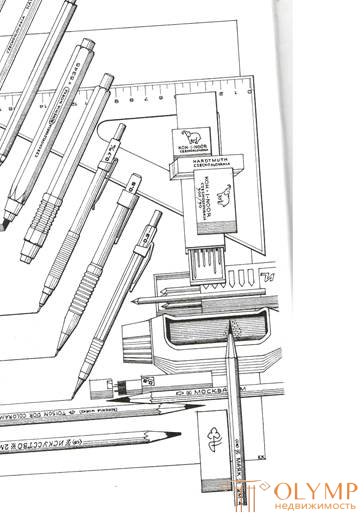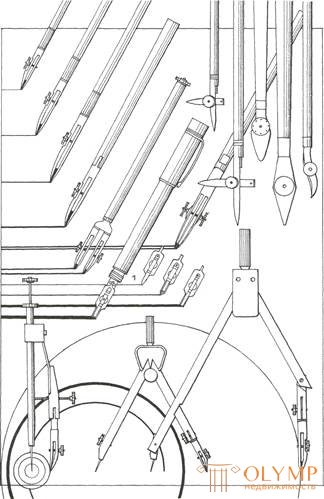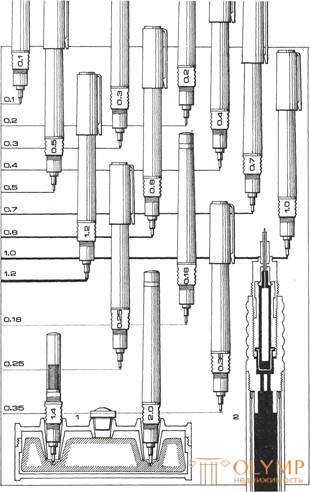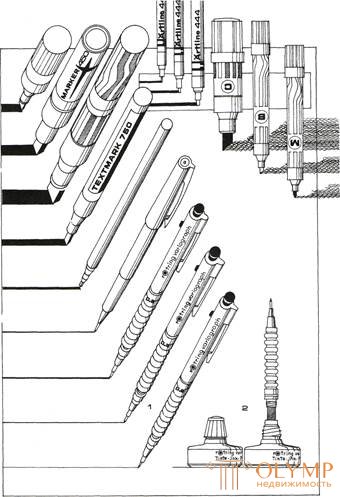
Simple pencils are the most convenient and versatile tools (Fig. 2). The ability to sharpen pencils with a sharp or flat cone, to leave a long or short stylus, allows each graphic to clearly adjust the usability of the tool in accordance with personal tastes and features of graphic work. The quality of the tool depends on the quality of the graphic rod (it should not be brittle), as well as on the properties, texture and softness of the wooden frame (the tree should be easy to sharpen, cut off in medium-sized even chips without chips).
In the project graphics, the following marking of pencils is used: for drawing - ST, 2Т, Т, ТМ (domestic marking), ЗН, 2Н, Н, F, НВ (foreign marking); for the drawing - TM, M, 2M, 3M, 4M, 5M, 6M (domestic labeling), F, HB, B, 2B, 3B, 4B, 5B, 6B (foreign labeling).
The use of mechanical pencils requires the skill of adjusting the force of pressure on the stylus; any involuntary pressure on the tool leads to the oblite of the stylus. When using a simple pencil, part of the effort when pressing on the stylus is absorbed by the wooden frame. Techniques of drawing and drawing with mechanical pencils with slate pencils of medium thickness and thick slate pencils have their own characteristics.

Fig. 2. Types of pencils, simple and automatic, erasers, slate rods, pencil sharpener
Drawing and drawing with mechanical pencils with sketches of average thickness (about 2 mm) differs little in character from the same work with ordinary pencils. A drawing, a rough drawing made with a mechanical pencil with a thick slate, is charcoal-like in nature, it will be coarsened with thick, intense lines and strokes. The marking of the leads is the same as for ordinary pencils.
Coal and sanguine for ease of drawing and sketching are inserted into special holders. Linear drawing with these materials has its own characteristics, as with the help of coal and sanguine, you can get a wide loose line that allows you to apply this technique in sketching drawings, clauses, in drawing and drawing on tracing paper, smooth and textured paper. In the process of working with these materials, it is necessary to remember that lines and strokes are drawn “without pressure, easily, as if sliding on paper”. Sharp pressure leads to breaking, crushing of coal sticks, sanguine, thick slate. You can erase the image with a clean cloth or a clean and very soft eraser.
Paint brushes for drawing and drawing are used extremely rarely. This technique of linear graphics is typical for Chinese and Japanese drawings. The elasticity of the line, its shape and the force of pressure depend on the coordinated movements of the hand and forearm, the correct position of the elbow joint and the body. Drawing with a brush must necessarily be accompanied by a vertical position of the brush relative to the plane of the paper. When grabbing the hand with the thumb and forefinger, support on the middle finger is not necessary. Depending on the need, the middle finger either fixes the lower end of the brush, then leaves it free.
Raspaderes are ideal tools for drawing straight and curved lines that form the basis of any drawing image. The quality of the router is determined by the following requirements:
- the outlines of the blades of the tool when viewed from above and below should be without asymmetric grinding one of the sides of the blade;
- when viewed from the side, the ends of the tool blades should be of the same length, i.e. one of the blades should not protrude with respect to the other (in this case, the scanner scratches the paper);
- the blades of the noisseder should not have burrs, sharp edges, chipping, distortions.
Defects of the rosfeder's blades are eliminated by sharpening on a soft wheel (with circular movements with light pressure).
In the process of drawing the plane of the pen, graphos, drawing of the pen should be parallel to the direction of the depicted line.

Fig. 3. Various types of reydeperov. Grafos (1)
- the instrument must be cleaned and cleaned in the intervals between work;
- in the process, the tool must be periodically shaken so that the needle with the piston moves freely in the tube, without which it is impossible to make high-quality lines;
- fill the rapidograph only with special mascara, filling it into a balloon in an amount not more than that required for one to three days work;
- in the process of work, constantly wipe the working parts of the instrument with a clean cloth.
When working with a rapidograph, do not:
- strongly press on the tubular-needle nozzle, as this causes the tool to deteriorate, the needle becomes clogged, and the paper is scratched;
- fill the cylinder with chemical ink or ink, since in this case all parts of the rapidograph should be washed immediately after the end of the drawing;
- use non-proprietary screwdrivers for disassembling and assembling the tool, exert great efforts when unscrewing and screwing up parts with thread.

Fig. 4 Rapidograph, Rapidomat (1); Rapidograph device (2)
To work with rapidographs the following devices are needed:
- squares, patterns, rulers, designed specifically for working with rapidographs and reisfederami should have edges with hooking. Such a device prevents the carcass from flowing under the plane of a square, ruler, piece. The best samples of such tools are made of transparent plastic of special strength.
Special erasers , simple and electrically operated (something like a milling cutter, which cuts off the contaminated surface of the paper) are used to erase the ink images from the surface of tracing paper and paper.

Fig. 5 Different types of markers: variograph (1), filling variograph (2)
Thin automatic pencils “micrographs” are instruments that became especially widespread in the late
Working with an automatic pencil allows the tool to be held obliquely relative to the paper plane. Micrograph leads are available in several soft versions - 2H, H, F, B, 2B. The drawing and the drawing executed by the micrograph differ in special grace and reserved simplicity.
Paper requirements:
a) when working with a reedfeder and felt-tip pen, there are no particularly stringent requirements for paper quality. It is advisable to draw on paper with a dense surface (Whatman paper or cardboard), but also on bad paper with loose, lint-free surfaces. Refefers and felt-tip pens can be used to draw lines. The lower the quality of the paper, the wider and with a more rounded end should be the rosfeder's blades, the thicker the felt-tip felt should be;
b) when working with graphosomes, rapidograph, variograph, micrograph it is necessary to pay special attention to the quality of the paper. These tools function well when drawing on paper with a smooth dense surface (drawing drawing paper), special pencil and ink tracing paper, graph paper. The mascara fits well on the surface of such sheets; feather of graphos, pipe carpidograph, thin automatic dowel pencil, move without difficulty, without scratching the paper. If you try to work with the listed tools on a paper with a loose, large-textured, lint-free surface, then the graphos feather, the rapid
The third group of tools for linear graphics consists of tools with which linear graphics is modeled from ready-made elements. These devices include special stencils and templates.
Stencils - sheets of thick plastic, plastic films with carved outlines of images of equipment parts; symbols used in technical, cartographic, architectural drawing; contours of circles, ellipses, etc. Stencils greatly simplify the work of a draftsman, engineer, architect, designer, but their use is advisable only when working on graphic drawings, where the nature of graphics should be extremely informative with a wide use of conventional symbols, a special style of coarse linear graphics in relatively thick lines. These devices are widely used in working drawing, working on technical drawings and diagrams. In training for this style of graphics you need to prepare purposefully. The skills of compositional work, acquired in the initial stages of training in the process of drawing, drawing with the use of various simple tools, are formed in a certain culture. These skills late in the new courses promote literate, conscious use of letrasets, stencils, templates.
Что бы оставить комментарий войдите
Комментарии (0)